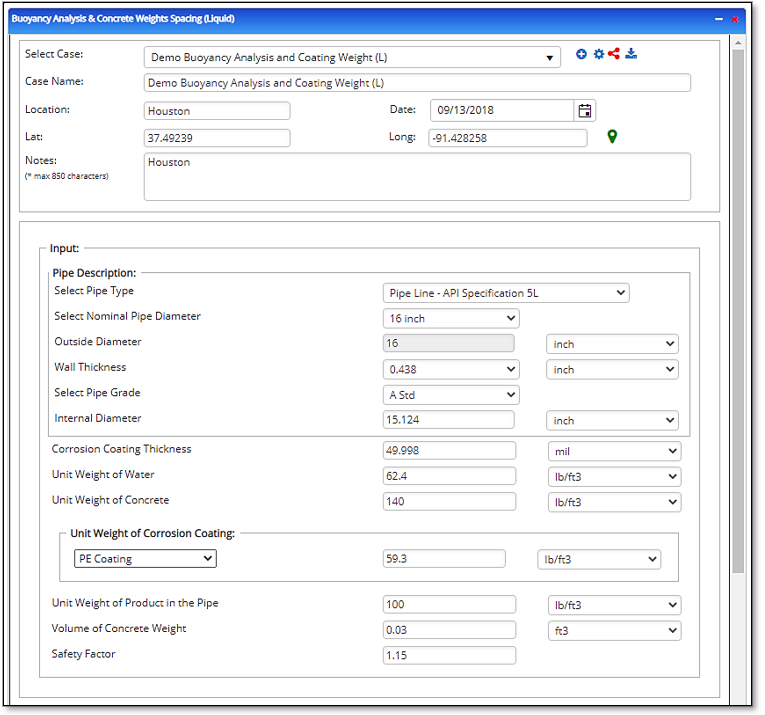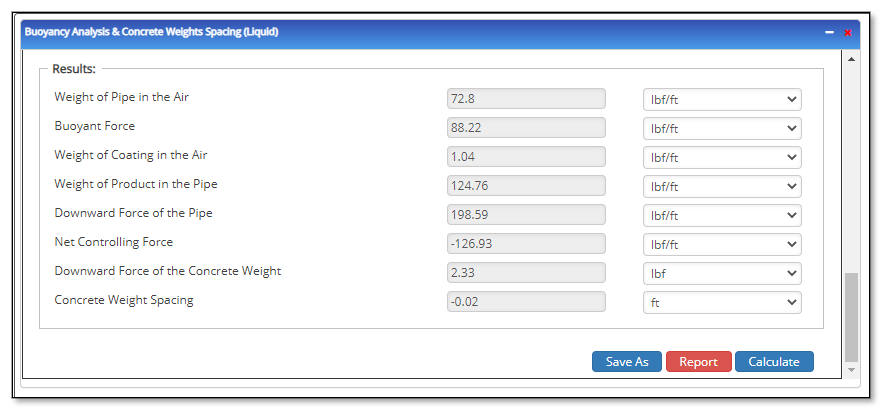Buoyancy Analysis & Concrete Weights Spacing
Calculating Buoyance Forces
The buoyancy of a pipeline depends upon the weight of the pipe, the weight of the volume of water displaced by the pipe, the weight of the liquid load carried by the pipe and the weight of the backfill. As a conservative analytical practice, consider the pipeline empty for two reasons; so, the weight of the liquid will be considered as an additional safety factor and the possibility of the pipeline not being in use during a period of time.
This calculation is used to determine downward forces and weights of a specified pipe resulting in the proper spacing of weights to counter the buoyance forces. The calculation does not account/allow for depth of water or burial.
Buoyance Force

Where:
𝐹𝐵 − Buoyancy Force(lbf)
𝐷𝑜 − Pipe outside diameter including coating (in)
𝛾𝑤 −Unit weight of fluid/water (lb/ft3)
Weight of steel pipe in the air
![]()
Where:
𝑊𝑃 − Weight of bare pipe in air (lbf)
𝐷𝑜𝑝 − Pipe outside diameter (in)
𝑡 − Pipe wall thickness(in)
Weight of pipe coating in the air
PTLB Design & Stress

Where:
𝑊𝑐 − Weight of coating in air(lbf)
𝛾𝑐 − Unit weight of coating(lb/ft3)
Weight of product in the pipe

Where:
𝑊𝑝𝑟 − Weight of product in pipe(lbf)
𝛾𝑝𝑟 − Unit weight of product in pipe(lb/ft3)
Downward force of the pipe
![]()
Net Controlling Force
![]()
Where:
𝐹𝑛𝑒𝑡 − Net controlling force(lbf)
𝑆𝐹 = Safety Factor
Downward force of the concrete weight
![]()
Where:
𝑉𝑤𝑡 − Weight of concrete(ft3)
𝛾𝑤𝑡 −Unit weight of concrete(lb/ft3)
𝛾𝑤 −Unit weight of fluid/water(lb/ft3)
Concrete weight spacing

Input Parameters
- To create a new case, click the “Add Case” button
- Select the Buoyancy Analysis & Concrete Weights Spacing application from the Steel Pipe – Design and Stress Analysis module
- Enter Case Name, Location, Date and any necessary notes
- Fill out all required fields
- Make sure the values you are inputting are in the correct units
- Click the CALCULATE button
- Nominal Pipe Size(in)
- Wall Thickness(in)
- Corrosion coating thickness (MIL) Unit
- Weight of product in pipe(lbs./ft³)
- Volume of Concrete weight(ft³)
- Unit Weight of Water(lbs./ft³)
- Unit Weight of Concrete(lbs./ft³)
- Unit Weight of Corrosion Coating (lbs./ft³)

Outputs/Reports
- View the results
- If an input parameter needs to be edited be sure to hit the CALCULATE button after the change
- To SAVE, fill out all required case details then click the SAVE button
- To rename an existing file, click the SAVE As button
- Provide all case info then click SAVE
- To generate a REPORT, click the REPORT button
- The user may export the Case/Report by clicking the Export to Excel/PowerPoint icon
- To delete a case, click the DELETE icon near the top of the widget
- Buoyancy Force(lbf/ft)
- Weight of Pipe in Air(lbf/ft)
- Weight of Coating in Air(lbf/ft)
- Weight of Product in Pipe(lbf/ft)
- Downward Force of the Pipe(lbf/ft)
- Net Controlling Force(lbf/ft)
- Downward Force of the Concrete Weight(lbf)
Concrete Weight Spacing(ft)

Related Links
Pipeline Design & Stress Analysis
Pipeline HUB — User Resources
